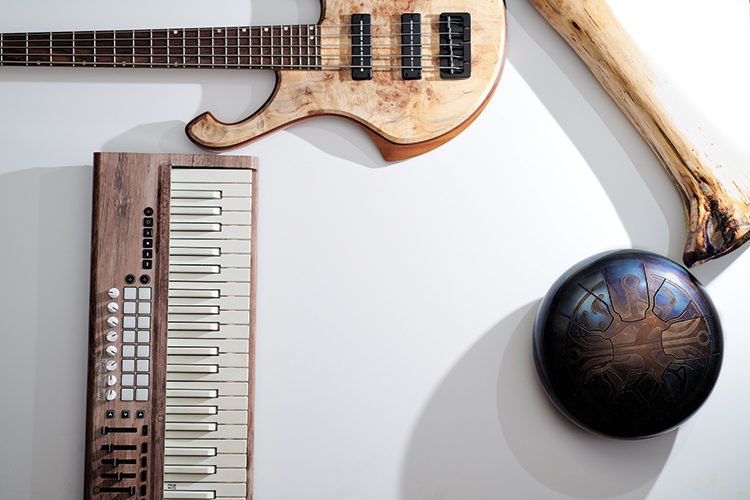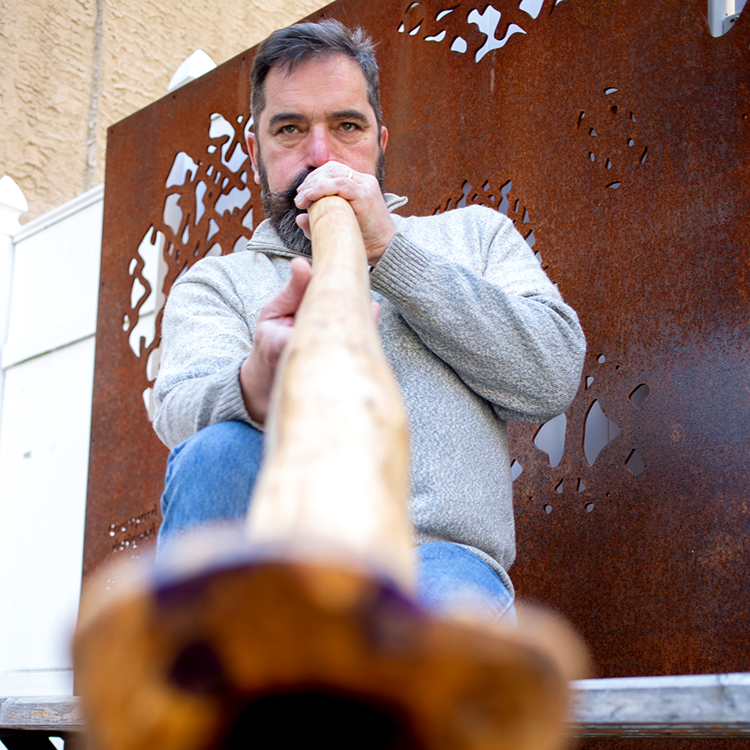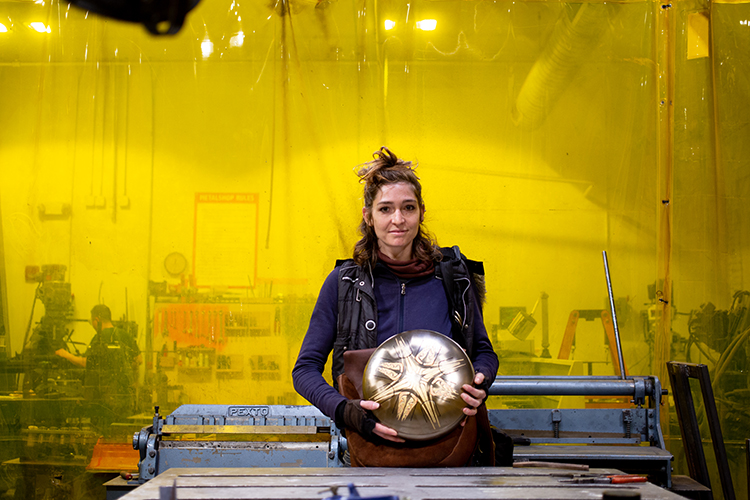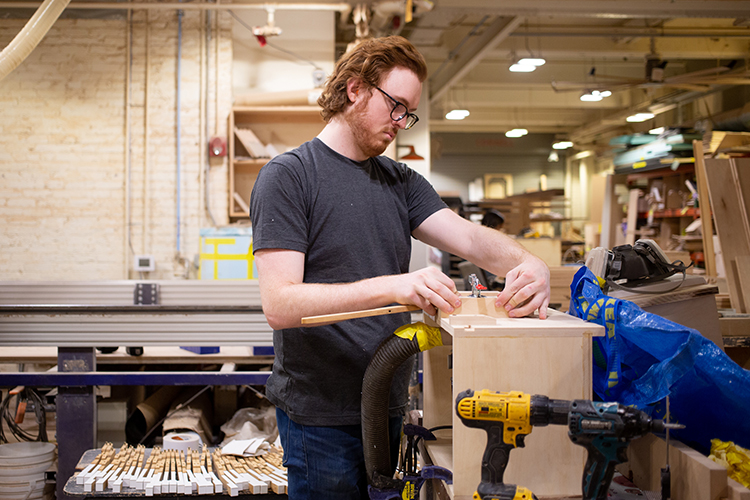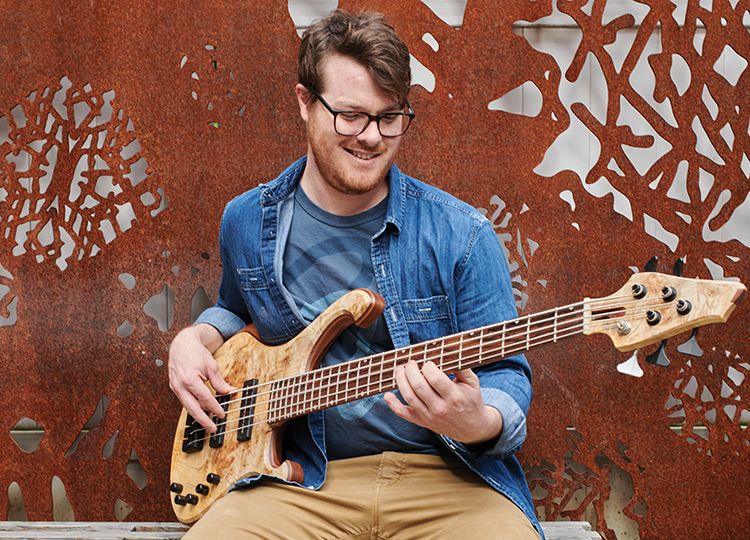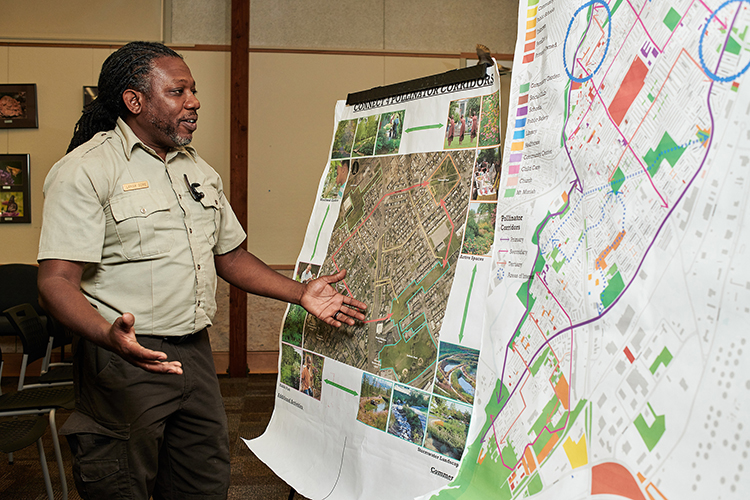Photo: Albert Yee
By Claire Marie Porter
Tinkering away in community workspaces throughout the city, a renaissance of artists are making both music and the instruments that create it.
At NextFab, a makerspace that offers high-quality tools and materials, as well as training sessions, members are free to create and invent what they please. Some come to design the next big thing, while others function on a much smaller scale.
Seeking a stronger connection to their craft, these musicians wanted to get intimate with their instruments—to take them apart and examine their insides, and then, make them better.
There’s an old German folk song that goes: “All things shall perish from under the sky. Music alone shall live, never to die.”
The lyric rings true in spaces like these, which remind us that music is the recurring motif of humankind.
From the earliest flutes, made 40,000 years ago from mammoth ivory and bird bones, to the pair of silver and bronze trumpets found in the pharaoh Tutankhamun’s tomb, the connection between humans and musical instruments has proved ancient and profound.
Historically, the ability to own or make an instrument was a privilege, and the object itself sacred. But today, musical instruments have been commodified to a point where no one knows their maker, and everyone has a guitar lying around.
We’re in the midst of a new maker movement—an era where innovative technology and artisanship coalesce in collaborative makerspaces. It’s a culture that’s turning consumers into creators, allowing DIYers to shape a block of wood into an electric guitar. Or, in some cases, transform a dead tree into a didgeridoo.
Photo: Margo Reed
Just didgeridoo it: With the help of termites, Scott Keeley carves out
one of the world’s most ancient instruments
Scott Keeley began playing didgeridoos to treat his sleep apnea.
“Didgeridoo players don’t snore,” he was told by his doctor.
The didgeridoo is one of the world’s oldest instruments. It’s in the wooden brass family and was invented by indigenous Australians. An experienced “didge” player can make a myriad of sounds, from animal imitations to explosive pops, along with the omnipresent droning hum that sounds like an alien abduction.
The name of the instrument is considered to be an onomatopoeic Western attempt to describe its sound: “didjerry, didjerry.”
Traditionally, it’s made from termite-eaten eucalyptus or agave tree trunks, says Keeley. One myth suggests the instrument is best made by burying a log underground and allowing termites to hollow it out.
Termites are still an important part of the process, though they don’t do the work alone. The best trees are those that are dead and termite-eaten, but still standing, says Keeley. Subterranean termites, or white termites, prefer darker, more humid areas, so they do most of their munching towards the center of the tree.
There’s little margin for error. If the tree has been dead too long, it will fall apart—if it’s too green, the instrument will split within a year. The rest is a mystery, says Keeley.
“Only one in 100 is an excellent didge, and we don’t know what makes it that way,” he says.
Keeley has gotten very good at finding the perfect dead standing tree.
You want the bark flaky, he explains, not completely sloughed off. Traditionally, the root of the tree would form the bell of the instrument, creating a natural flare.
The best didge-making trees are those that have had a hard life, he says. The best instrument he’s made to date was from an 80-foot-tall, dead black birch.
When he began to cut at the roots, he noticed that they had fought to get their nutrition, growing around a rock. This made it so the base of the tree already had a natural bend, and when Keeley knocked it over, an enormous puddle of termites poured out.
“I really ruined their day,” he says. But it made the perfect didge.
The process is straightforward: Keeley preps the outside, then sands the trunk with a belt sander, tapering the wood to the top. He uses tools and materials from
NextFab South Philadelphia, where he works as a patent agent.
After treating the outside of the trunk and cleaning up its roots, Keeley slices the whole thing lengthwise and carves it like a dugout canoe. He shapes the mouthpiece and glues the two halves back together, then sands, polishes and plays.
The whole process takes about four days.
There’s a final mystery in the making—a maker can’t know what key the didge will be in until it’s complete. It depends on the growth of the tree and the hollowing work of the termites. The majority of Keeley’s end up being in the keys of E or F major.
Keeley’s didgeridoo is about as tall as he is, around 5 feet and 8 inches.
He plays it on a still, sunlit day in the
NextFab courtyard space, placing one foot on top of the other—eyes focused, lips pursed—as he creates a low drone that mingles with the sounds of construction next door.
It took him about six months to learn circular breathing.
“My technique was to just make some kind of hooty-tooty noise while breathing,” Keeley says.
“I’ve only found three other didge-makers on the East Coast. So, I guess that makes me the third-best didgeridoo maker here,” he says, laughing.
Photo: Margo Reed
In the key of meditation: Samurai-style swordsmithing meets music in Michele Judge’s handiwork
Michele judge, a percussionist and jewelry-maker, began making her own drums after playing a friend’s steel tongue drum in southern Mexico. To her, the sound and feel of the instrument was intoxicating.
“I had to have one of these,” she says.
The steel tongue drum is a mix between two idiophonic instruments that are played on the lap: the handpan and Hang.
The Hang was invented in 2000 by two Swiss men as a meditative tool. The process for making the dome-shaped instrument was kept a mystery in order to avoid commercialism; to purchase one, an interested buyer had to write an essay to prove their worthiness, says Judge. It’s a large instrument, 52 centimeters in diameter and 24 high, and looks like a flying saucer.
The handpan is a relatively new instrument. It was created in 2007 by an American steelpan maker as an alternative and successor to the highly elusive Hang, and became popular quickly. While smaller than the Hang, it retains its swollen, domed shape.
Judge’s instrument, the steel tongue drum, is smaller yet, and was invented around the same time as the handpan by another steel drum maker, using the bottoms of 20-gallon propane tanks.
The idea of combining her artist’s eye and desire for a transportable meditative instrument led her to the seven-pound, saucer-shaped dome, with eight notes.
Judge partnered with a glass and leather artist, Carly Freedman, and together they founded Mayuca Drums. The company’s early models were made from old propane tanks, like the initial invention.
Now, 25 models later, Judge’s drums, made from sheets of mild steel, are so intricately beautiful that some customers buy them solely as decorations. The design is made with a white clay heat treatment process used in traditional Japanese swordsmithing, allowing for color variation. The designs and notes are mostly made with a water jet, a large machine that can cut through a foot of steel, which Judge has access to through her makerspace membership.
“It’s a meditative tool,” she says of the drum. “You’re focused on what you’re doing, but your mind is clear. Your hands get used to making the sounds … and the instrument becomes a voice.”
Judge plays one of her drums in the stairwell of NextFab. Her hands tenderly find a pattern on the symmetrical grid of the instrument, and the sounds grow, cocooning the space with long, drawn-out chimes. The tones are reflective.
The drum she plays on is tuned in A-minor pentatonic, her favorite key.
When Beethoven or Schubert composed in the key of A-flat, they considered it the “key of the grave.” It was common prior to the 20th century to associate different keys with certain emotions. A-minor is considered a very womanly key, invoking tenderness of character.
When Judge was first learning her craft, a drummer instructed her to play with her eyes closed.
“You can really feel and hear it when your eyes are closed,” she says.
Later, she grew more in sync with how her hands moved.
“Now it just takes you on this journey, and it can be emotional,” she says. “It’s the essence of who you are, coming through this instrument.”
Photo: Margo Reed
Piano Man: Piano technician Tom Rudnitsky doesn’t just fix old pianos, he reclaims their souls
While Tom Rudnitsky doesn’t make instruments from scratch, he restores them—or as he might describe it, he saves their souls.
“New pianos can be very green behind the ears,” he says. “Older pianos, they’ve been through a lot. You get this sense of history in the object.”
Rudnitsky is a composer and pianist who became a mostly self-taught piano technician after a music-career proved to be financially unsustainable.
“Piano restoration has been both an incredibly fun journey in its own right, and a means of creating financial stability as an artist,” he says, though pursuing music is still a long-term goal.
He was always drawn to the inner workings of the piano.
“In music school, you’d sometimes see the piano technician on staff, pulling the action [the mechanical assembly of parts inside the body of the piano] out of the piano,” he says. “It looked so cool.”
Rudnitsky was always a tinkerer, he says, always taking things apart. So, when a customer would ask him to fix a loose key on a tuning job, he would figure out how to do it. He gathered tools and knowledge until, finally, customers were asking him if he could restore their pianos for them.
Rudnitsky started working on piano actions out of his apartment.
“I think everyone who starts has a cardboard box they keep all their tools in,” he says.
The process gets very messy very quickly. Sometimes, Rudnitsky would have to give up his living room for a week, sacrificing it to house piano parts.
The process of restoring piano keys alone can take up to 35 hours.
“This involves precisely milling the keys, trimming the new plastic keytops to size, and then leveling and aligning all of the keys back in the piano,” he says.
If he’s rebuilding an entire piano the whole process could take up to 300 hours.
The goal is to make as consistent-sounding an instrument as possible.
“When you play the piano, every key should feel the same,” he says.
He rolls out several different tool bags, a spread that looks something like if Bob Ross and a surgeon combined their wares.
“It takes about ten times as many tools to make something as you’d think,” he says.
The woodworking culture is dominated by white males in the suburbs working alone in the basement, says Rudnitsky. So, a collaborative space like NextFab allows people from all walks of life to jump into that world without having to have a garage or surplus cash.
“I get excited when people other than the typical woodworker wearing the flannel shirt is working,” he says. “Everyone should be able to do this.”
Rudnitsky works on sandblasting keys from a 1920s upright piano in NextFab. The ivory natural keys and black sharps are in bundles of seven or eight notes. When removed from the piano, they look a bit like hermit crabs out of their shells.
He takes the bundle of keys to the sandblaster, a machine that uses an abrasive mixture of sand and air to literally “blast” rust and dirt off a surface. In about five seconds, the wood on the piano lever arms changes from a dull brown to a bright, fresh-looking wood.
“It’s deeply satisfying,” he says.
Pianos don’t always have significant financial value, says Rudnitsky, but the personal value can be high, and a bond with an instrument is difficult for a musician to find.
“You can get a brand new piano,” he says. “It just doesn’t have the soul you’re looking for.”
Photo: Albert Yee
Pulling the strings: Ryan Hyde turns a block of wood into a guitar with excellent woodworking skills and a musician’s eye
Ryan Hyde makes guitars and basses from scratch at NextFab. Over the course of six months, blocks of raw wood become customized, high-quality instruments. He is a luthier, a word derived from the French word “luth,” meaning lyre, that has evolved to describe someone who builds stringed instruments comprised of a neck and sound box.
“What you can make by hand can transcend what you can get in a store,” says Hyde.
Hyde has been playing music since high school.
“Being a player helps inform what I do,” he says. It also allows him to understand what someone is looking for when they come to him with a request.
And he has always been a maker.
“As soon as I got into instruments and making music, I also got into taking things apart and seeing how I could make them better,” he says.
Fifteen years ago, when his friends were picking colleges, Hyde was looking for places he could make his own instruments. In order to get an apprenticeship with an instrument-maker, you have to be a decent woodworker, he says.
His guitar-making pursuits lead him to study industrial design at the University of the Arts, and while enrolled, he took a tour of NextFab and knew it would be the best way to afford his endeavors. Now, he has a day job at NextFab in member services, and works on his craft at night.
“I always gravitated towards the craftsmanship that went into a customized instrument,” Hyde says.
The process to make a guitar or bass requires a few select woods, usually mahogany, walnut, maple or poplar.
“I like to use poplar,” says Hyde. “It’s easy to paint, it doesn’t weigh a lot and it has good characteristics.”
The neck and body start out as blocks of wood from a lumber mill. The body is simple: a slab with some pockets, routed out for the pickups and electronics, with holes drilled in the neck for a bridge.
All of Hyde’s guitars end up being unique.
“You could get into ergonomics,” he says, “but in general, it’s a block of wood cut into a cool shape that you like.”
Photo: Margo Reed
It’s electric: Matt Garfield transforms instruments into kaleidoscopic light displays
For some, making and customizing instruments is the practical solution to unsustainable artistic ventures. For Matt Garfield, modifying instruments is a marriage between art and technology.
Garfield, frontman of electropunk band Mose Giganticus, was a professional musician for seven years, five of which he spent touring full-time. He got a master’s degree in electrical engineering while continuing to perform.
Coming out of the touring life, Garfield got a job in IT and became the senior electrical engineer at NextFab four-and-a-half years ago, in what he describes as fortuitous circumstances.
Now, he’s found a synthesis of his two passions—embedding electronics in existing instruments, which he describes as a “collaboration” between his artistry and engineering skills.
On his computer in his NextFab office space, Garfield brings up pictures of a MIDI controller keyboard he bought off the shelf, documenting his processes through images. He took apart the keyboard and embedded electronics and custom lighting in it, resulting in a highly-customized look you can’t find anywhere else, he says.
“I put a lot of effort into the whole visual aesthetics of the instrument, the interplay between controlled lighting … and the music itself,” he says.
Garfield offers to do some quick live programming, and after ten minutes of clicking and coding, the keyboard attached to his computer becomes a multi-colored light show.
He still plays drums and keyboard and sings for Mose Giganticus, and his most recent instrument-modding project was for a music video he produced himself.
In the video, the drums, guitars and keyboard swirl with colors and move with the sound on a stage. The result is psychedelic and haunting.
Garfield creates what he can’t buy.
“Either because I can’t afford it,” he says, “or because it doesn’t exist at all.”
Drumming up business: Ethan Feinstein handcrafts drums because every musician deserves a unique bond with their instrument
Ethan Feinstein, a drummer of 17 years, wanted a very specific size and sound from his drums—something he couldn’t find in stores. He collaborated with a friend on his first project, a single drum, using resources from NextFab’s North Philadelphia location. After that, a friend asked him to build a full drum set.
Feinstein realized then that there weren’t any custom drum makers in Philly. Feeling it was important to have local, high-quality, handcrafted instruments, he started the Philadelphia Drum Company six months ago.
“Being able to build it with my hands brings me that much closer to the instrument,” he says. “Musicians have a very close bond to their instrument. It’s the tool you use to make your music.”
Feinstein wants to be able to provide that intimate connection for all drummers.
“We make all the shells by hand, using raw lumber,” he says.
Making the shell is similar to making a barrel for aging wine. Usually, a drum shell is made by taking thin veneers and bending them into shape, which puts a lot of tension on the wood, Feinstein says.
He instead uses solid pieces of wood called staves, and glues them together into a 20-sided circle to create the drum shell, then using a jig and router to round out the outside and inside of the drum. It’s a unique process for drum-making
“Then the drum is more officially a drum,” he says.
Feinstein puts on the bearing edges using a table router, and from there, begins the finishing process, which involves sealing and finishing the wood, laser-engraving the badges, punching them out of bronze and setting them into the drum. Lastly, all the holes for the hardware are drilled and filled.
The hardware currently consists of industry-standard parts, but the company is hoping to manufacture its own by next year.
The Philadelphia Drum Company’s primary service is building customized snare drums and sets. All the shells are built by hand using local wood.
Feinstein says the great community of artists and craftspeople at NextFab are integral to his work.
“I’ve met so many people that are becoming part of the company,” he says.
One of the first full drum sets Feinstein built is also one of his favorites. It’s made of black walnut. But, ultimately, each drum he’s made holds a special place in his heart.
“They’re all my children,” he says.

